The Relationship between Yield Curve and Economic Activity: An Analysis of G7 Countries
Abstract
1. Introduction
2. Literature
3. Materials and Methods
4. Results
4.1. Graphical Analysis of the Term Spreads in G7 Countries
4.2. Correlation Analysis
4.3. Regression Results
5. Discussion
6. Conclusions
Author Contributions
Funding
Institutional Review Board Statement
Informed Consent Statement
Data Availability Statement
Acknowledgments
Conflicts of Interest
Appendix A
| Equation: | ||||||||||||||
| Horizon (k Months) | Canada | France | Germany | Italy | Japan | UK | US | |||||||
| , | , | , | , | , | , | , | ||||||||
| 1 | 2.94 *** (0.703) | 0.04, 297 | 0.54 † (0.756) | <0.01 †, 239 | 6.03 *** (1.964) | 0.02, 158 | −2.78 ** (1.076) | 0.02, 115 | 3.59 *,† (1.845) | <0.01 †, 259 | 0.68 (0.453) | <0.01 †, 299 | 0.63 (0.519) | <0.01 †, 347 |
| 3 | 2.65 *** (0.600) | 0.09, 295 | 2.32 ** (1.067) | 0.03, 237 | 6.65 *** (1.550) | 0.09, 156 | −2.02 *** (0.755) | 0.07, 113 | 2.59 ** (1.187) | <0.01 †, 292 | 0.87 (0.422) | 0.02, 297 | 0.61 (0.551) | 0.01, 345 |
| 6 | 2.26 *** (0.536) | 0.10, 292 | 2.40 ** (1.127) | 0.06, 234 | 7.26 *** (1.879) | 0.16, 153 | −2.10 *** (0.583) | 0.16, 110 | 2.02 * (1.152) | <0.01 †, 289 | 0.88 ** (0.417) | 0.05, 294 | 0.67 (0.520) | 0.01, 342 |
| 12 | 1.69 *** (0.533) | 0.10, 286 | 2.57 ** (1.121) | 0.13, 228 | 7.66 *** (2.122) | 0.32, 147 | −1.91 *** (0.426) | 0.23, 104 | 1.58 (1.206) | <0.01 †, 259 | 0.85 * (0.452) | 0.08, 288 | 0.94 * (0.463) | 0.03, 336 |
| 24 | 1.29 *** (0.486) | 0.12, 274 | 1.83 *** (0.668) | 0.15, 216 | 5.09 *** (1.219) | 0.37, 135 | −1.72 *** (0.221) | 0.41, 92 | -0.74 (0.736) | <0.01 †, 271 | 0.53 * (0.321) | 0.07, 276 | 1.40 *** (0.468) | 0.14, 324 |
| Equation: , for k = 24, j = 12 | ||||||||||||||
| Horizon | Canada | France | Germany | Italy | Japan | UK † | US | |||||||
| , | , | , | , | , | , | , | ||||||||
| k = 24, j = 12 | 2.16 (1.806) | 0.02, 273 | 2.89 (2.453) | 0.01, 216 | 7.33 (6.025) | 0.03, 135 | −4.17 *** (1.218) | 0.20, 92 | −7.76 (0.015) | 0.02, 271 | 0.31 (0.331) | 0.001, 276 | 6.197 *** (2.499) | 0.16, 324 |
| Notes: ***, **, and * indicate significance level at a 1%, 5%, and 10% level, respectively. † The start date of the sample was readjusted to 1996M01. | ||||||||||||||
| Equation:, for k = 36, j = 24 | ||||||||||||||
| Horizon | Canada | France | Germany† | Italy | Japan | UK | US | |||||||
| , | , | , | , | , | , | , | ||||||||
| k = 36, j = 24 | 2.16 ** (0.937) | 0.08, 261 | 0.65 (1.232) | <0.001 †, 198 | −0.96 (2.086) | 0.03, 101 | −2.75 *** (0.753) | 0.23, 80 | −4.61 * (2.368) | 0.07, 259 | 0.511 (0.485) | 0.01, 264 | 4.01 *** (0.9340) | 0.31, 312 |
| Notes: We report HAC standard errors and covariance (Bartlett kernel, Newey–West fixed bandwidth = 5); ***, **, and * indicate the coefficient is statistically significant at a 1%, 5% and 10% level, respectively. † Sample for Germany was re-adjusted to 2007M08-2019M02 to correct for negative . Constant term is not significant in all cases, hence not reported to save space. is the adjusted coefficient of determination, and is the sample size. Source: Authors’ estimation Source: Authors’ estimation. | ||||||||||||||
| Equation: | ||||||||||||
| Horizon (k Months) | Canada | France | Germany | |||||||||
| , | , | , | ||||||||||
| 1 | 2.92 *** (0.765) | 0.04 (0.365) | <0.01 (0.096) | 0.03, 296 | 1.77 (1.404) | −0.32 (0.474) | −0.35 *** (0.097) | 0.11, 238 | 6.14 *** (2.287) | −0.20 (1.105) | −0.05 (0.208) | 0.01, 157 |
| 3 | 2.45 *** (0.596) | −0.10 (0.301) | 0.07 (0.072) | 0.10, 294 | 2.18 ** (0.984) | −0.43 (0.406) | −0.05 (0.058) | 0.04, 236 | 6.12 *** (1.377) | −0.59 (1.129) | 0.11 (0.127) | 0.12, 155 |
| 6 | 2.10 *** (0.517) | −0.16 (0.267) | 0.06 (0.054) | 0.11, 291 | 2.14 ** (0.948) | −0.62 (0.428) | −0.02 (0.031) | 0.09, 233 | 6.55 *** (1.367) | −1.11 (1.316) | 0.06 (0.059) | 0.20, 152 |
| 12 | 1.63 *** (0.520) | −0.20 (0.224) | 0.01 (0.027) | 0.10, 285 | 2.24 ** (0.936) | −0.67 ** (0.330) | −0.01 (0.013) | 0.19, 227 | 6.87 *** (1.533) | −1.41 (0.953) | 0.01 (0.021) | 0.40, 146 |
| 24 | 1.28 *** (0.466) | −0.19 (0.197) | −0.01 (0.014) | 0.12, 273 | 1.43 *** (0.510) | −0.65 *** (0.204) | −0.02 *** (0.006) | 0.30, 215 | 4.31 *** (0.997) | −1.42 *** (0.382) | −0.04 *** (0.013) | 0.59, 134 |
| Horizon (k Months) | Italy | Japan | UK | |||||||||
| , | , | , | ||||||||||
| 1 | −3.56 ** (1.460) | 0.60 (1.220) | −0.38 *** (0.062) | 0.15, 114 | 5.71 *** (1.845) | −5.66 ** (2.908) | 0.09 (0.164) | 0.01, 293 | 0.97 * (0.531) | 0.20 (0.189) | −0.19 ** (0.96) | 0.03, 298 |
| 3 | −1.44 (0.931) | −1.71 * (0.921) | −0.13 *** (0.029) | 0.18, 112 | 6.12 *** (1.972) | −6.53 * (3.485) | 0.05 (0.113) | 0.02, 291 | 1.04 ** (0.442) | 0.13 (0.141) | −0.06 (0.054) | 0.03, 296 |
| 6 | −1.45 ** (0.650) | −1.53 ** (0.672) | −0.05 *** (0.016) | 0.24, 109 | 6.11 *** (2.200) | −7.42 * (4.11) | 0.04 (0.055) | 0.05, 288 | 0.95 ** (0.403) | 0.05 (0.119) | −0.02 (0.031) | 0.05, 293 |
| 12 | −1.03 ** (0.440) | −1.86 *** (0.551) | −0.03 ** (0.013) | 0.38, 103 | 4.89 ** (2.199) | −6.77 * (3.852) | −0.02 (0.027) | 0.07, 282 | 0.86 ** (0.430) | 0.002 (0.094) | −0.007 (0.017) | 0.07, 287 |
| 24 | −1.06 *** (0.294) | −1.54 ** (0.628) | −0.03 *** (0.008) | 0.60, 91 | 0.51 (1.010) | −2.18 (2.251) | −0.03 * (0.013) | 0.04, 270 | 0.52 * (0.297) | −0.02 (0.088) | −0.01 (0.006) | 0.07, 275 |
| Horizon (k Months) | US | |||||||||||
| , | ||||||||||||
| 1 | 0.93 ** (0.380) | 0.36 * (0.212) | 0.22 ** (0.093) | 0.06, 346 | ||||||||
| 3 | 0.79 ** (0.398) | 0.27 (0.188) | 0.26 *** (0.067) | 0.16, 344 | ||||||||
| 6 | 0.77 ** (0.401) | 0.20 (0.178) | 0.24 *** (0.064) | 0.18, 341 | ||||||||
| 12 | 1.01 *** (0.417) | 0.21 (0.154) | 0.18 *** (0.046) | 0.13, 335 | ||||||||
| 24 | 1.67 *** (0.466) | 0.27 ** (0.127) | 0.05 * (0.024) | 0.19, 323 | ||||||||
| Equation: , for k = 24, j = 12 | ||||||||||||
| Horizon (k Months) | Canada | France | Germany | |||||||||
| , | , | , | ||||||||||
| k = 24, j = 12 | 2.09 (1.696) | −0.20 (0.286) | −0.02 (0.024) | 0.02, 273 | 2.48 (2.209) | −0.66 * (0.393) | −0.03 ** (0.012) | 0.08, 215 | 4.79 (5.255) | −1.32 (1.292) | −0.09 *** (0.033) | 0.13, 134 |
| Horizon (k Months) | Italy | Japan | UK | |||||||||
| , | , N | , | ||||||||||
| k = 24, j = 12 | −3.55 ** (1.588) | −0.43 (0.837) | −0.01 (0.015) | 0.19, 91 | −12.86 * (6.796) | 2.78 (2.903) | −0.03 * (0.019) | 0.03, 270 | −0.06 (0.274) | −0.09 (0.135) | −0.02 (0.014) | <0.01, 275 |
| Horizon (k Months) | US | |||||||||||
| , | ||||||||||||
| k = 24, j = 12 | 6.42 *** (2.444) | 0.05 (0.177) | −0.06 ** (0.026) | 0.17, 323 | ||||||||
| Equation:, for k = 36, j = 24 | ||||||||||||
| Horizon (k Months) | Canada | France | Germany | |||||||||
| , | , N | , | ||||||||||
| k = 36, j = 24 | 2.17 ** (0.914) | −0.05 (0.190) | −0.01 (0.017) | 0.08, 261 | 0.01 (1.017) | −0.38 * (0.204) | −0.02 ** (0.008) | 0.04, 203 | −1.43 (2.377) | −0.72 (0.781) | −0.06 *** (0.023) | 0.09, 122 |
| Horizon (k Months) | Italy | Japan | UK | |||||||||
| , N | , N | , | ||||||||||
| k = 36, j = 24 | −2.37 ** (0.945) | −0.40 (0.488) | −0.01 (0.011) | 0.22, 79 | −9.33 *** (2.981) | 3.94 ** (1.782) | −0.02 ** (0.008) | 0.15, 258 | 0.46 (0.475) | −0.02 (0.088) | −0.01 (0.007) | 0.01, 263 |
| Horizon (k Months) | US | |||||||||||
| , | ||||||||||||
| k =36, j = 24 | 4.54 *** (0.908) | 0.29 ** (0.124) | −0.04 *** (0.018) | 0.35, 311 | ||||||||
| Equation: | ||||||||||||||||
| Horizon (k Months) | Canada | France | Germany | |||||||||||||
| , | , | , | ||||||||||||||
| 1 | −0.41 (0.379) | −0.08 (1.296) | 6.04 *** (1.971) | −0.02 (0.098) | 0.05, 296 | −0.99 (0.626) | 0.43 (1.917) | 7.49 ** (3.574) | −0.36 *** (0.092) | 0.12, 238 | −1.49 (1.749) | −1.64 (4.709) | 16.2 (11.34) | −0.06 (0.196) | 0.03, 157 | |
| 3 | −0.29 (0.303) | −1.33 (1.13) | 2.60 * (1.526) | 0.07 (0.072) | 0.10, 294 | −1.07 ** (0.522) | −0.26 (1.126) | 6.97 *** (2.255) | −0.06 (0.053) | 0.10, 236 | −1.76 (1.539) | −2.48 (2.834) | 14.6 * (7.906) | 0.10 (0.115) | 0.17, 155 | |
| 6 | −0.27 (0.262) | −1.54 (1.089) | 1.54 (1.460) | 0.05 (0.053) | 0.12, 291 | −1.01 ** (0.488) | −1.32 (1.172) | 4.30 ** (1.705) | −0.02 (0.029) | 0.13, 233 | −1.94 (1.453) | −4.69 * (2.444) | 10.2 * (5.391) | 0.05 (0.052) | 0.24, 152 | |
| 12 | −0.25 (0.231) | −1.59 (1.004) | 0.54 (1.254) | 0.01 (0.027) | 0.10, 285 | −0.97 ** (0.382) | −1.87 * (1.050) | 3.10 ** (1.397) | −0.02 (0.013) | 0.23, 227 | −2.40 *** (0.848) | −4.75 ** (2.102) | 12.2 *** (3.917) | 0.01 (0.019) | 0.50, 146 | |
| 24 | −0.18 (0.218) | −1.49 * (0.879) | −0.05 (1.021) | −0.01 (0.014) | 0.12, 273 | −0.70 *** (0.196) | −1.90 ** (0.783) | 0.52 (0.909) | −0.02 *** (0.006) | 0.30, 215 | −1.70 *** (0.289) | −4.78 *** (1.232) | 3.24 (2.111) | −0.04 *** (0.014) | 0.60, 134 | |
| 24,12 | −0.18 (0.298) | −1.27 (1.198) | −0.40 (1.501) | −0.02 (0.024) | 0.03, 273 | −0.41 (0.278) | −1.97 (1.408) | −2.13 (1.508) | −0.03 ** (0.012) | 0.09, 215 | −0.80 (1.220) | −4.98 * (2.738) | −6.22 (4.653) | −0.09 *** (0.030) | 0.16, 134 | |
| 36,24 | 0.06 (0.215) | −1.94 *** (0.674) | −1.19 (0.891) | −0.01 (0.017) | 0.12, 261 | 0.03 (0.209) | −1.31 (0.883) | −3.62 ** (1.433) | −0.01 (0.008) | 0.17, 203 | 0.29 (0.747) | −2.76 * (1.585) | −10.0 *** (3.468) | −0.05 *** (0.018) | 0.27, 122 | |
| Horizon (k Months) | Italy | Japan | UK | |||||||||||||
| , | , | , | ||||||||||||||
| 1 | 1.27 (1.510) | 3.16 (3.149) | −2.73 (4.422) | −0.37 *** (0.063) | 0.14, 114 | −5.04 * (2.837) | −11.80 ** (4.572) | −7.65 (7.862) | 0.09 (0.163) | 0.01, 293 | 0.04 (0.318) | −0.18 (1.204) | 1.25 (2.143) | −0.19 * (0.095) | 0.03, 298 | |
| 3 | −1.61 (1.065) | −0.43 (1.861) | −0.42 (2.162) | −0.13 *** (0.030) | 0.17, 112 | −6.30 ** (3.099) | −12.79 ** (5.462) | −2.70 (8.159) | 0.05 (0.113) | 0.02, 291 | −0.002 (0.253) | −0.43 (0.810) | 1.02 (1.602) | −0.06 (0.053) | 0.03, 296 | |
| 6 | −1.25 * (0.760) | −0.47 (1.411) | −1.11 (1.650) | −0.05 *** (0.018) | 0.24, 109 | −7.37 ** (−3.692) | −13.56 ** (6.298) | −0.56 (7.237) | 0.04 (0.055) | 0.05, 288 | −0.04 (0.187) | −0.56 (0.603) | 0.70 (1.039) | −0.02 (0.031) | 0.05, 293 | |
| 12 | −1.57 *** (0.581) | −1.17 (1.103) | −1.08 (1.150) | −0.03 ** (0.013) | 0.38, 103 | −7.05 * (3.836) | −11.47 ** (5.759) | 3.24 (4.740) | −0.02 (0.026) | 0.07, 282 | −0.17 (0.180) | −0.23 (0.491) | 1.32 (1.066) | −0.01 (0.016) | 0.09, 287 | |
| 24 | −1.11 * (0.685) | −1.06 (0.958) | −1.72 ** (0.689) | −0.02 *** (0.007) | 0.64, 91 | −1.90 (2.178) | −2.88 (3.112) | −2.98 (3.406) | −0.03 * (0.014) | 0.05, 270 | −0.03 (0.140) | −0.50 (0.387) | 0.07 (0.682) | −0.01 * (0.006) | 0.06, 275 | |
| 24, 12 | −0.08 (0.855) | −0.20 (1.330) | −2.13 * (1.129) | −0.02 (0.014) | 0.21, 91 | 3.24 (2.602) | 5.76 (4.652) | −9.17 (5.982) | −0.03 * (0.020) | 0.06, 270 | 0.09 (0.149) | −0.75 (0.605) | −1.14 (0.853) | −0.02 (0.013) | 0.01, 275 | |
| 36, 24 | −0.35 (0.555) | −0.43 (1.017) | −1.35 (1.129) | −0.01 (0.012) | 0.16, 79 | 3.84 ** (1.872) | 6.93 *** (2.544) | −9.51 * (4.999) | −0.02 ** (0.008) | 0.24, 258 | 0.26 ** (0.118) | −1.14 ** (0.498) | −1.70 ** (0.659) | −0.01 * (0.07) | 0.09, 263 | |
| Horizon (k Months) | US | |||||||||||||||
| , | ||||||||||||||||
| 1 | 0.16 (0.232) | 0.09 (0.562) | 1.78 (1.197) | 0.21 (0.106) | 0.06, 346 | |||||||||||
| 3 | 0.10 (0.255) | 0.05 (0.552) | 1.54 (1.160) | 0.26 (0.070) | 0.16, 344 | |||||||||||
| 6 | 0.04 (0.255) | −0.02 (0.536) | 1.15 (1.144) | 0.24 *** (0.073) | 0.18, 341 | |||||||||||
| 12 | 0.06 (0.234) | −0.36 (0.577) | 1.35 (1.215) | 0.15 *** (0.042) | 0.13, 335 | |||||||||||
| 24 | 0.114 (0.211) | −0.91 * (0.539) | 1.27 (1.161) | 0.04 ** (0.019) | 0.20, 323 | |||||||||||
| 24, 12 | 0.093 (0.302) | −1.29 (0.947) | 1.51 (1.864) | −0.06 ** (0.026) | 0.17, 323 | |||||||||||
| 36, 24 | 0.43 ** (0.215) | −2.21 ** (0.887) | −0.19 (1.172) | −0.04 ** (0.021) | 0.38, 311 | |||||||||||
Appendix B
References
- Afonso, António, and Manuel M.F. Martins. 2012. Level, slope, curvature of the sovereign yield curve, and fiscal behaviour. Journal of Banking & Finance 36: 1789–807. [Google Scholar]
- Argyropoulos, Efthymios, and Elias Tzavalis. 2016. Forecasting economic activity from yield curve factors. The North American Journal of Economics and Finance 36: 293–311. [Google Scholar] [CrossRef]
- Argyropoulos, Efthymios, and Elias Tzavalis. 2018. The influence of real interest rates and risk premium effects on the ability of the nominal term structure to forecast inflation. The Quarterly Review of Economics and Finance. [Google Scholar] [CrossRef]
- Bekaert, Geert, Seonghoon Cho, and Antonio Moreno. 2010. New Keynesian macroeconomics and the term structure. Journal of Money, Credit and Banking 42: 33–62. [Google Scholar] [CrossRef]
- Bordo, Michael D., and Joseph G. Haubrich. 2008a. The yield curve as a predictor of growth: Long-run evidence, 1875–997. The Review of Economics and Statistics 90: 182–85. [Google Scholar] [CrossRef]
- Bordo, Michael D., and Joseph G. Haubrich. 2008b. Forecasting with the yield curve; level, slope, and output 1875–997. Economics Letters 99: 48–50. [Google Scholar] [CrossRef]
- Boukhatem, Jamel, and Hayfa Sekouhi. 2017. What does the bond yield curve tell us about Tunisian economic activity? Research in International Business and Finance 42: 295–303. [Google Scholar] [CrossRef]
- Chinn, Menzie, and Kavan Kucko. 2015. The predictive power of the yield curve across countries and time. International Finance 18: 129–56. [Google Scholar] [CrossRef]
- Cox, C. John, Jonathan E. Ingersoll, and Stephen A. Ross. 1981. A re-examination of traditional hypotheses about the term structure of interest rates. The Journal of Finance 36: 769–99. [Google Scholar] [CrossRef]
- Culbertson, John Mathew. 1957. The term structure of interest rates. The Quarterly Journal of Economics 71: 485–517. [Google Scholar] [CrossRef]
- D’Agostino, Antonello, Domenico Giannone, and Paolo Surico. 2006. (Un)predictability and Macroeconomic Stability. Working Paper Series No. 605. Frankfurt: European Central Bank, pp. 1–43. Available online: http://sdw.central.banktunnel.eu/pub/pdf/scpwps/ecbwp605.pdf (accessed on 1 February 2019).
- Dery, Cosmas, and Apostolos Serletis. 2019. Interest rates, money, and economic Activity. Macroeconomic Dynamics, 1–50. Available online: https://www.cambridge.org/core/journals/macroeconomic-dynamics/article/interest-rates-money-and-economic-activity/3B2A01D7DBBD9F6BDBFD9F91531E7AB5 (accessed on 12 January 2020). [CrossRef]
- Dewachter, Hans, Leonardo Iania, and Marco Lyrio. 2014. Information in the yield curve: A Macro-Finance approach. Journal of Applied Econometrics 29: 42–64. [Google Scholar] [CrossRef]
- Diebold, Francis X., and Canlin Li. 2006. Forecasting the term structure of government bond yields. Journal of Econometrics 130: 337–64. [Google Scholar] [CrossRef]
- Diebold, Francis X., Monika Piazzesi, and Glenn D. Rudebusch. 2005. Modeling bond yields in finance and macroeconomics. American Economic Review 95: 415–20. [Google Scholar] [CrossRef]
- Duffee, Gregory R. 2002. Term premia and interest rate forecasts in affine models. The Journal of Finance 57: 405–43. [Google Scholar] [CrossRef]
- Duffee, Gregory R. 2011. Information in (and not in) the term structure. The Review of Financial Studies 24: 2895–934. [Google Scholar] [CrossRef]
- Estrella, Arturo, and Gikas A. Hardouvelis. 1991. The term structure as a predictor of real economic activity. The Journal of Finance 46: 555–76. [Google Scholar] [CrossRef]
- Fama, Eugene F., and Robert R. Bliss. 1987. The information in long-maturity forward rates. The American Economic Review 77: 680–92. Available online: https://www.jstor.org/stable/1814539 (accessed on 2 February 2019).
- Fendel, Ralf, Nicola Mai, and Oliver Mohr. 2019. Predicting Recessions Using Term Spread at the Zero Lower Bound: The Case of the Euro Area. VOX CEPR Policyt Portal. January 17. Available online: https://voxeu.org/article/predicting-recessions-using-term-spread-zero-lower-bound (accessed on 8 April 2019).
- Feroli, Michael. 2004. Monetary policy and the information content of the yield spread. The BE Journal of Macroeconomics 4: 1–15. [Google Scholar] [CrossRef]
- FocusEconomics. 2019. Italy Economic Outlook. Barcelona: FocusEconomics. Available online: https://www.focus-economics.com/countries/italy (accessed on 15 April 2019).
- Fusion Media. 2019a. Investment.com. Available online: https://www.investing.com/rates-bonds/ (accessed on 2 February 2019).
- Fusion Media. 2019b. Investment.com. Available online: https://www.investing.com/about-us/ (accessed on 2 February 2019).
- Giacomini, Raffaella, and Barbara Rossi. 2006. How stable is the forecasting performance of the yield curve for output growth? Oxford Bulletin of Economics and Statistics 68: 783–95. [Google Scholar] [CrossRef]
- Girardi, Annalisa. 2019. Italy Falls Back into Recession as the World Fears Global Economic Slowdown. Forbes. Available online: https://www.forbes.com/sites/annalisagirardi/2019/02/01/italy-falls-back-into-recession-as-the-world-fears-global-economic-slowdown/#3e3b0590225f (accessed on 15 April 2019).
- Gupta, Rangan, Hylton Hollander, and Rudi Steinbach. 2020. Forecasting output growth using a DSGE-based decomposition of the South African yield curve. Empirical Economics 58: 351–78. [Google Scholar] [CrossRef]
- Ha, Jongrim. 2020. Nonlinear transmission of U.S. monetary policy shocks to international financial markets. International Finance. Available online: https://onlinelibrary.wiley.com/doi/abs/10.1111/infi.12371 (accessed on 30 March 2020). [CrossRef]
- Hännikäinen, Jari. 2017. When does the yield curve contain predictive power? Evidence from a data-rich environment. International Journal of Forecasting 33: 1044–64. [Google Scholar] [CrossRef]
- Harvey, Campbell R. 1988. The real term structure and consumption growth. Journal of Financial Economics 22: 305–33. [Google Scholar] [CrossRef]
- Kessel, Reuben A. 1965. Explanations of the term structure of interest rates. In The Cyclical Behavior of the Term Structure of Interest Rates. Edited by R. A. Kessel. Cambridge: National Bureau of Economic Research, pp. 5–43. Available online: https://www.nber.org/chapters/c1662 (accessed on 4 February 2019).
- Kounis, Nick. 2018. Global Daily—Who Owns Italian Bonds? ABN-AMRO. Available online: https://insights.abnamro.nl/en/2018/05/global-daily-who-owns-italian-bonds/ (accessed on 2 April 2019).
- Krugman, Paul. 2011. Conscience of a Liberal. Italy versus Japan. The New York Times. Available online: https://krugman.blogs.nytimes.com/2011/07/16/italy-versus-japan/ (accessed on 2 April 2019).
- Levant, Jared, and Jun Ma. 2017. A dynamic Nelson-Siegel yield curve model with Markov switching. Economic Modelling 67: 73–87. [Google Scholar] [CrossRef]
- Mody, Ashoka, and Mark P. Taylor. 2003. The high-yield spread as a predictor of real economic activity: Evidence of a financial accelerator for the United States. IMF Staff Papers 50: 373–402. [Google Scholar] [CrossRef]
- Møller, Stig V. 2014. GDP growth and the yield curvature. Finance Research Letters 11: 1–7. [Google Scholar] [CrossRef]
- Morell, Joseph. 2018. The decline in the predictive power of the US term spread: A structural interpretation. Journal of Macroeconomics 55: 314–31. [Google Scholar] [CrossRef]
- Nelson, Charles R., and Andrew F. Siegel. 1987. Parsimonious modeling of yield curves. Journal of Business 60: 473–89. [Google Scholar] [CrossRef]
- Newey, Whitney K., and Kenneth D. West. 1987. Hypothesis testing with efficient method of moments estimation. International Economic Review 28: 777–87. Available online: https://www.jstor.org/stable/2352957 (accessed on 2 April 2019). [CrossRef]
- OECD. 2018. Revenue Statistics 2018: Tax Revenue Trends in the OECD. OECD. Available online: https://www.oecd.org/tax/tax-policy/revenue-statistics-highlights-brochure.pdf (accessed on 2 April 2019).
- OECD. 2019a. Industrial Production Indicator. OECD. Available online: https://data.oecd.org/industry/industrial-production.htm (accessed on 2 February 2019).
- OECD. 2019b. Economic Outlook No. 104. November 2018: General Government Financial Balances, % of Nominal GDP, Forecast. OECD.Stat. Available online: https://stats.oecd.org/Index.aspx?QueryId=51643 (accessed on 2 April 2019).
- Orphanides, Athanasios, and Min Wei. 2012. Evolving macroeconomic perceptions and the term structure of interest rates. Journal of Economic Dynamics and Control 36: 239–54. [Google Scholar] [CrossRef][Green Version]
- Pham, Peter. 2017. When will Japan’s Debt Crisis Implode? Forbes. Available online: https://www.forbes.com/sites/peterpham/2017/12/11/when-will-japans-debt-crisis-implode/#12d63df94c6d (accessed on 15 April 2019).
- Piazzesi, Monika. 2005. Bond yields and the Federal Reserve. Journal of Political Economy 113: 311–44. [Google Scholar] [CrossRef]
- Plakandaras, Vasilios, Juncal Cunado, Rangan Gupta, and Mark E. Wohar. 2017. Do leading indicators forecast US recessions? A nonlinear re-evaluation using historical data. International Finance 20: 289–316. [Google Scholar] [CrossRef]
- Prasanna, Krishna, and Subramaniam Sowmya. 2017. Yield curve in India and its interactions with the US bond market. International Economics and Economic Policy 14: 353–75. [Google Scholar] [CrossRef]
- Roubini, Nouriel. 2019. Risk of Global Recession May Be Low but We Are Heading for Slowdown. The Guardian. February 8. Available online: https://www.theguardian.com/business/2019/feb/08/risk-of-global-recession-may-be-low-but-we-are-heading-for-slowdown (accessed on 2 April 2019).
- Rudebusch, Glenn D., and Tao Wu. 2008. A macro-finance model of the term structure, monetary policy and the economy. The Economic Journal 118: 906–26. [Google Scholar] [CrossRef]
- Shahzad, Syed Jawad Hussain, Safwan Mohd Nor, Ronald Ravinesh Kumar, and Walid Mensi. 2017. Interdependence and contagion among industry-level US credit markets: An application of wavelet and VMD based copula approaches. Physica A: Statistical Mechanics and Its Applications 466: 310–24. [Google Scholar] [CrossRef]
- Sowmya, Subramaniam, Krishna Prasanna, and Saumitra Bhaduri. 2016. Linkages in the term structure of interest rates across sovereign bond markets. Emerging Markets Review 27: 118–39. [Google Scholar] [CrossRef]
- Stock, James H., and Mark W. Watson. 2004. Combination forecasts of output growth in a seven-country data set. Journal of Forecasting 23: 405–30. [Google Scholar] [CrossRef]
- Sumner, Scott. 2019. Why Is the Public Debt Situation in Italy Worse than in Japan? Fiscal Space, Italy Japan, Public Debt. The Library of Economics and Liberty. March 21. Available online: https://www.econlib.org/why-is-the-public-debt-situation-in-italy-worse-than-in-japan/ (accessed on 2 April 2019).
- The US Department of the Treasury. 2019. Daily Treasury Yield Rates; Washington, DC: The Department of the Treasury. Available online: https://www.treasury.gov/resource-center/data-chart-center/interest-rates/Pages/TextView.aspx?data=yieldAll (accessed on 2 February 2019).
- Vieira, Fausto, Marcelo Fernandes, and Fernando Chague. 2017. Forecasting the Brazilian yield curve using forward-looking variables. International Journal of Forecasting 33: 121–31. [Google Scholar] [CrossRef]
- Walker, Andrew. 2018. What’s Behind Italy’s Economic Turbulence. BBC Business News. Available online: https://www.bbc.com/news/business-45751416 (accessed on 15 April 2019).
- Zoli, Edda. 2013. Italian Sovereign Spreads: Their Determinants and Pass-Through to Bank Funding Costs and Lending Conditions. IMF Working Paper WP/13/84. Washington, DC: International Monetary Fund, pp. 1–26. [Google Scholar] [CrossRef]
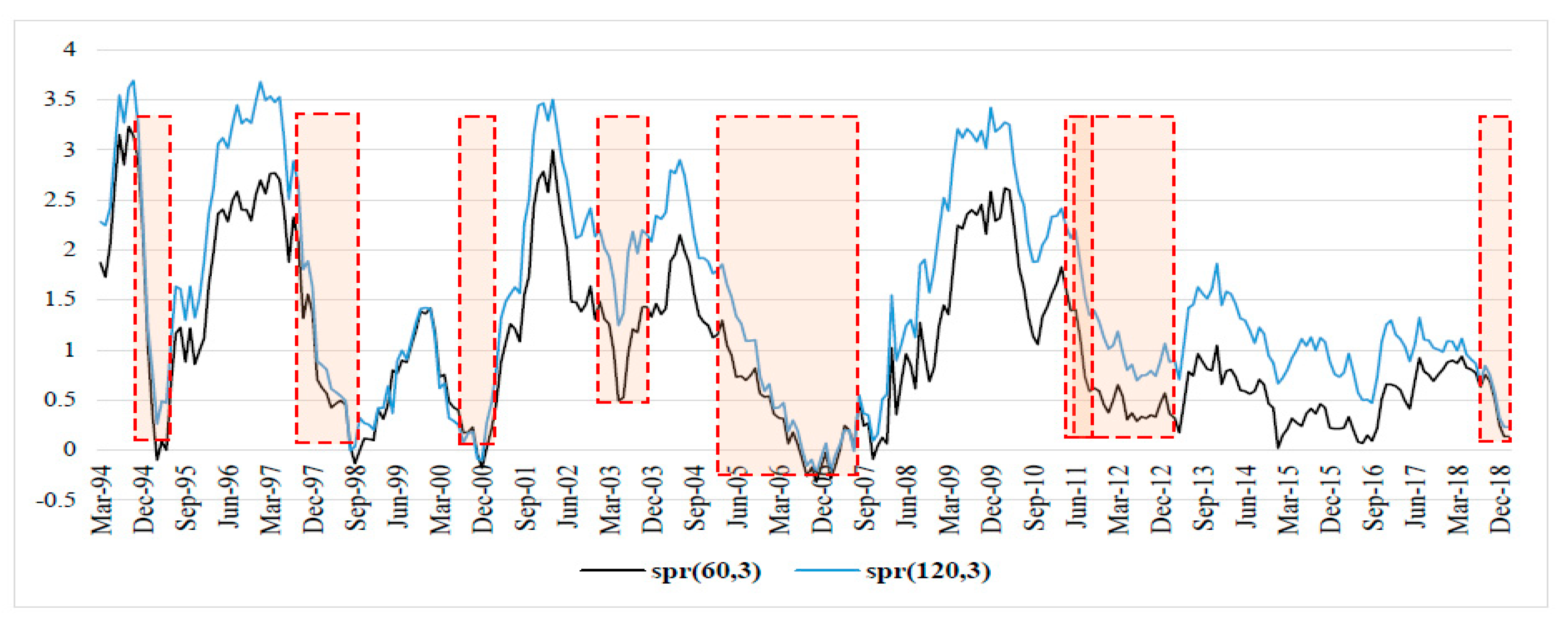
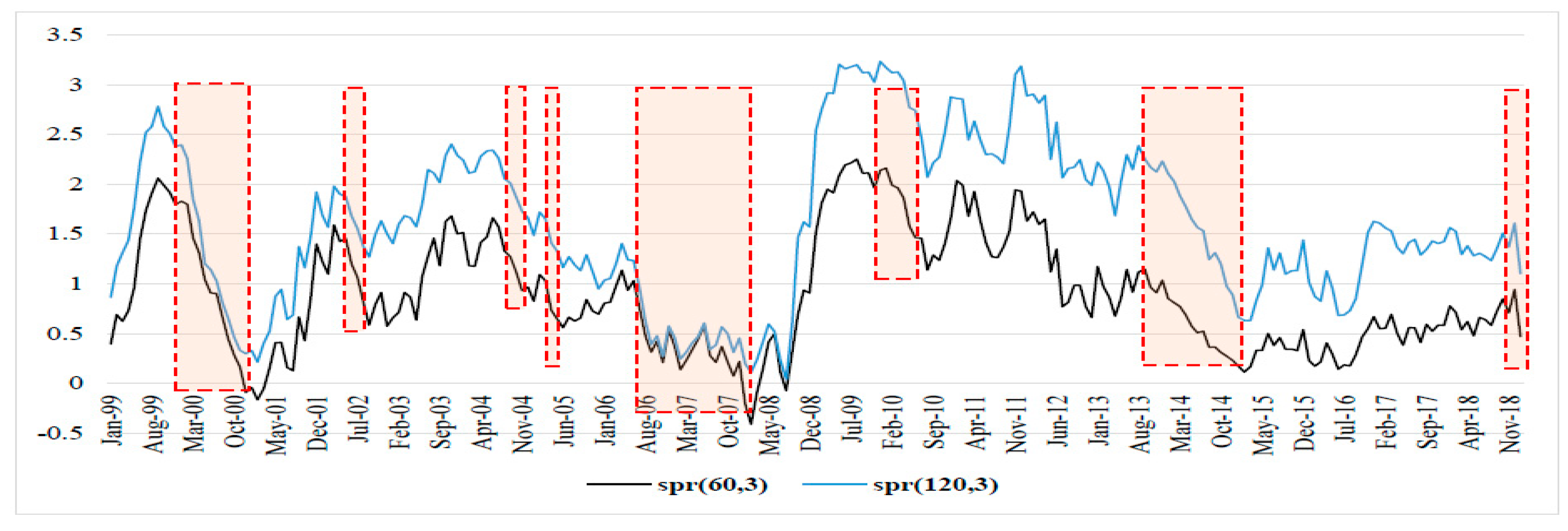
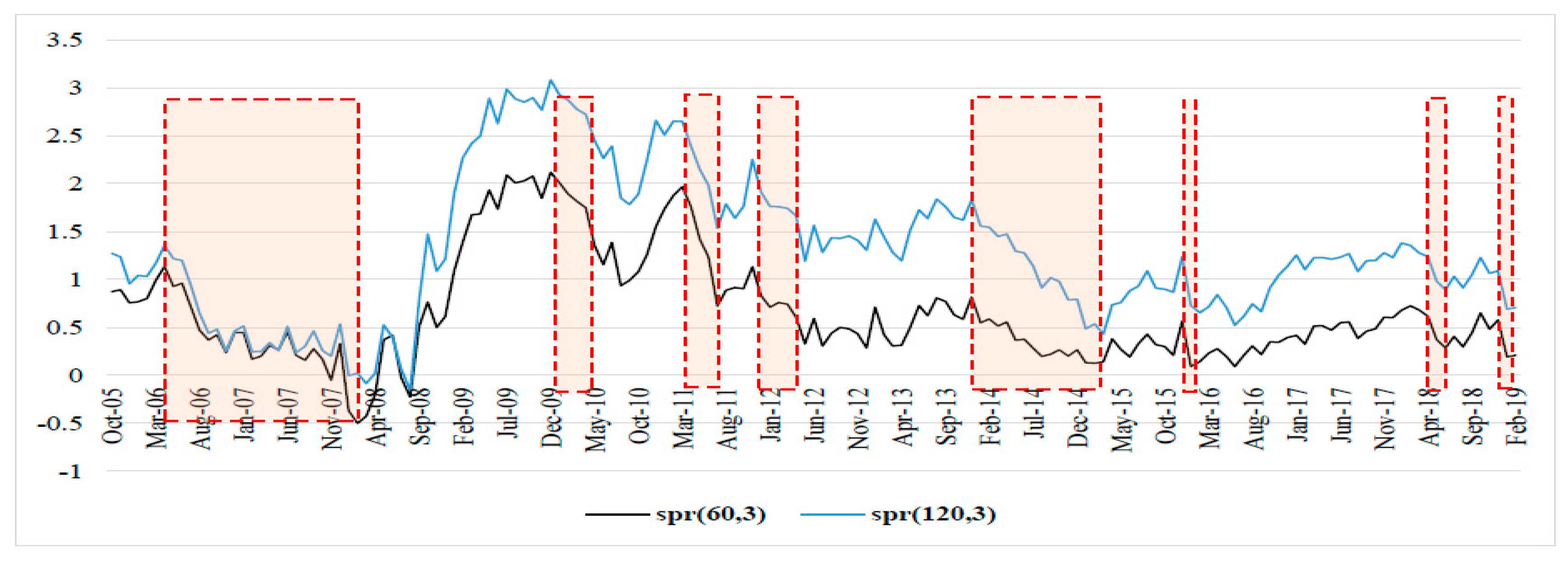
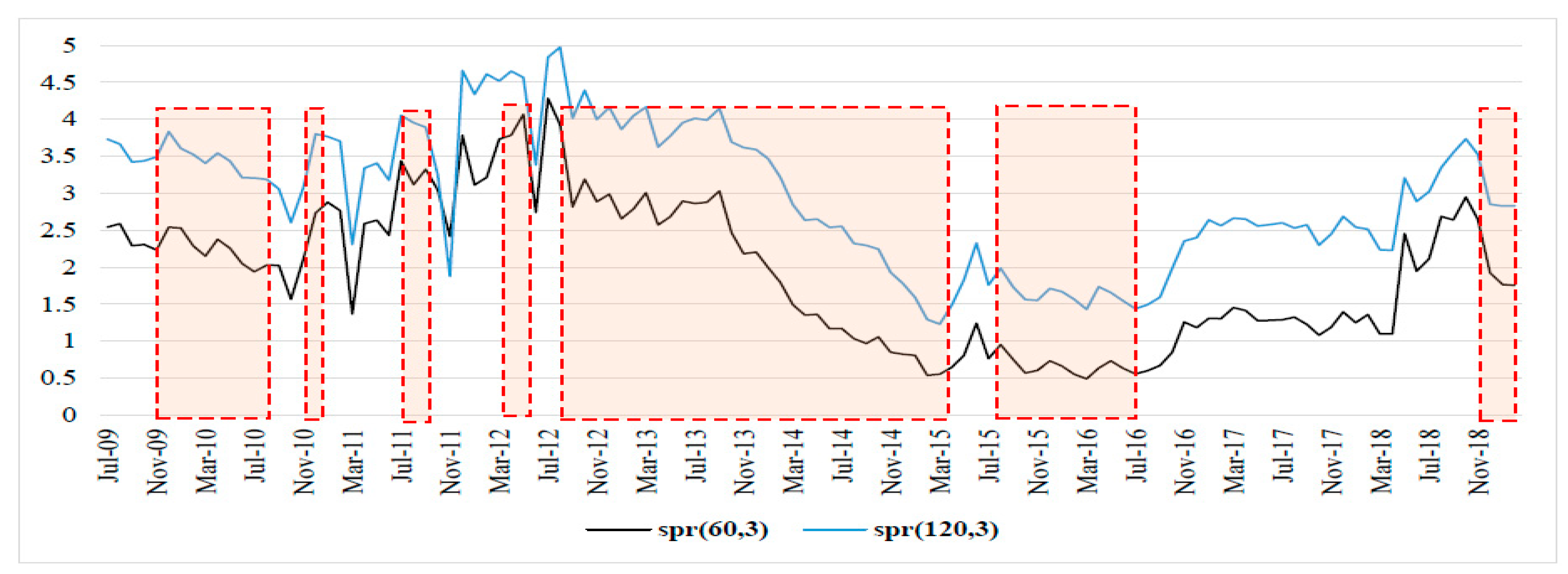
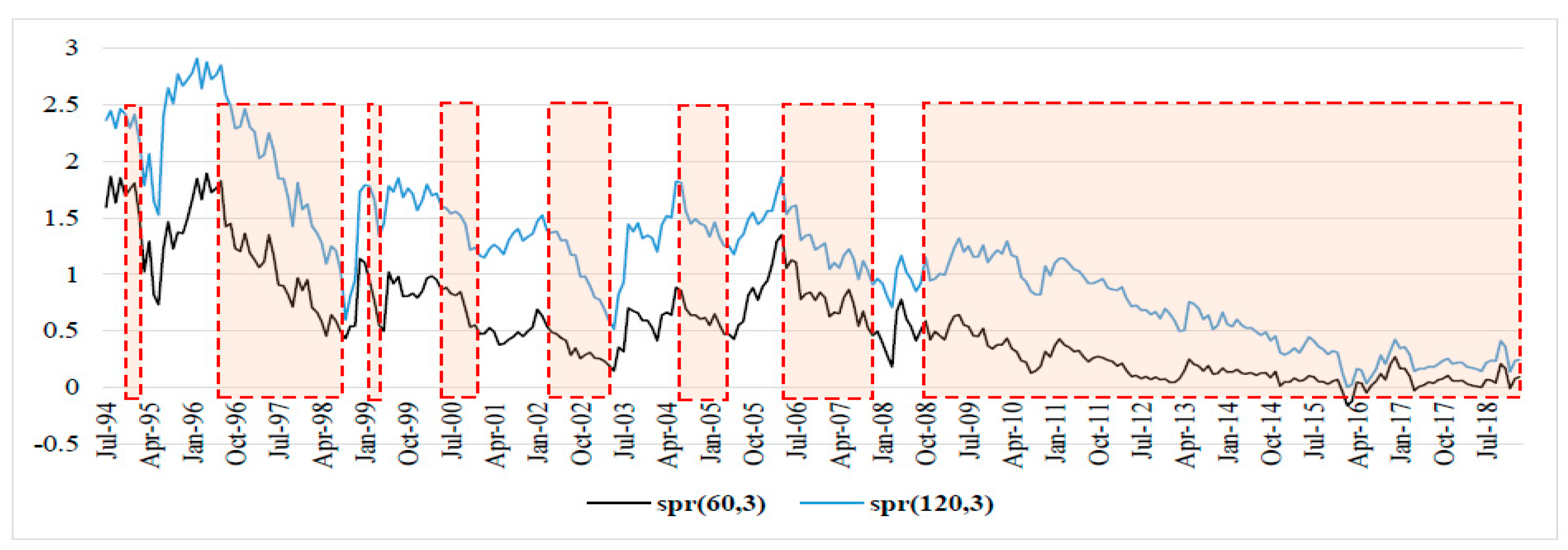

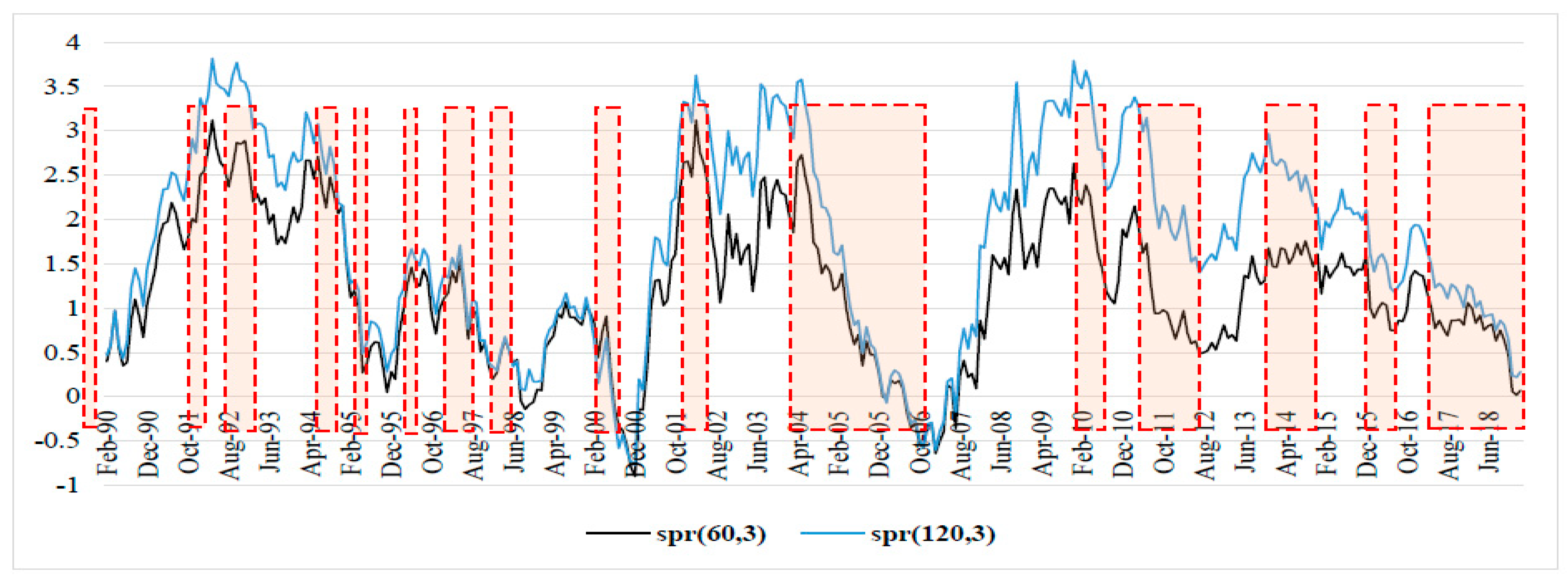

| Country | Canada | France | Germany | Italy | Japan | UK | US |
|---|---|---|---|---|---|---|---|
| Canada | 1.000 | ||||||
| ----- | |||||||
| [300] | |||||||
| France | 0.68 *** | 1.000 | |||||
| (<0.01) | ----- | ||||||
| [241] | [241] | ||||||
| Germany | 0.84 *** | 0.92 *** | 1.000 | ||||
| (<0.01) | (<0.01) | ----- | |||||
| [161] | [160] | [161] | |||||
| Italy | 0.27 *** | 0.67 *** | 0.39 *** | 1.000 | |||
| (<0.01) | (<0.01) | (<0.01) | ----- | ||||
| [116] | [115] | [116] | [116] | ||||
| Japan | 0.40 *** | 0.23 *** | 0.25 *** | 0.45 *** | 1.000 | ||
| (<0.01) | (<0.01) | (<0.01) | (<0.01) | ----- | |||
| [296] | [241] | [161] | [116] | [296] | |||
| UK | 0.59 *** | 0.64 *** | 0.78 *** | 0.11 | 0.08 | 1.000 | |
| (<0.01) | (<0.01) | (<0.01) | (0.23) | (0.17) | ----- | ||
| [300] | [241] | [161] | [116] | [296] | [302] | ||
| US | 0.70 *** | 0.50 *** | 0.52 *** | −0.12 | −0.08 | 0.68 *** | 1.000 |
| (<0.01) | (<0.01) | (<0.01) | (0.21) | (0.15) | (<0.01) | ----- | |
| [300] | [241] | [161] | [116] | [296] | [302] | [349] |
Publisher’s Note: MDPI stays neutral with regard to jurisdictional claims in published maps and institutional affiliations. |
© 2021 by the authors. Licensee MDPI, Basel, Switzerland. This article is an open access article distributed under the terms and conditions of the Creative Commons Attribution (CC BY) license (http://creativecommons.org/licenses/by/4.0/).
Share and Cite
Kumar, R.R.; Stauvermann, P.J.; Vu, H.T.T. The Relationship between Yield Curve and Economic Activity: An Analysis of G7 Countries. J. Risk Financial Manag. 2021, 14, 62. https://doi.org/10.3390/jrfm14020062
Kumar RR, Stauvermann PJ, Vu HTT. The Relationship between Yield Curve and Economic Activity: An Analysis of G7 Countries. Journal of Risk and Financial Management. 2021; 14(2):62. https://doi.org/10.3390/jrfm14020062
Chicago/Turabian StyleKumar, Ronald Ravinesh, Peter Josef Stauvermann, and Hang Thi Thu Vu. 2021. "The Relationship between Yield Curve and Economic Activity: An Analysis of G7 Countries" Journal of Risk and Financial Management 14, no. 2: 62. https://doi.org/10.3390/jrfm14020062
APA StyleKumar, R. R., Stauvermann, P. J., & Vu, H. T. T. (2021). The Relationship between Yield Curve and Economic Activity: An Analysis of G7 Countries. Journal of Risk and Financial Management, 14(2), 62. https://doi.org/10.3390/jrfm14020062






